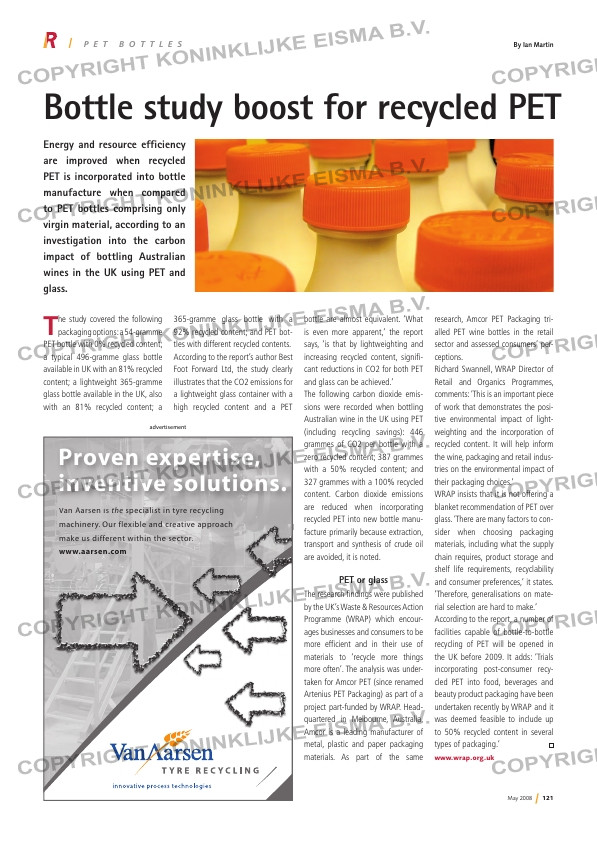Page 121 from: May 2008

May 2008 121
By Ian Martin p e t b o t t l e s
Bottle study boost for recycled PET
Energy and resource efficiency
are improved when recycled
PET is incorporated into bottle
manufacture when compared
to PET bottles comprising only
virgin material, according to an
investigation into the carbon
impact of bottling Australian
wines in the UK using PET and
glass.
The study covered the following packaging options: a 54-gramme
PET bottle with 0% recycled content;
a typical 496-gramme glass bottle
available in UK with an 81% recycled
content; a lightweight 365-gramme
glass bottle available in the UK, also
with an 81% recycled content; a
365-gramme glass bottle with a
92% recycled content; and PET bot-
tles with different recycled contents.
According to the report’s author Best
Foot Forward Ltd, the study clearly
illustrates that the CO2 emissions for
a lightweight glass container with a
high recycled content and a PET
bottle are almost equivalent. ‘What
is even more apparent,’ the report
says, ‘is that by lightweighting and
increasing recycled content, signifi-
cant reductions in CO2 for both PET
and glass can be achieved.’
The following carbon dioxide emis-
sions were recorded when bottling
Australian wine in the UK using PET
(including recycling savings): 446
grammes of CO2 per bottle with a
zero recycled content; 387 grammes
with a 50% recycled content; and
327 grammes with a 100% recycled
content. Carbon dioxide emissions
are reduced when incorporating
recycled PET into new bottle manu-
facture primarily because extraction,
transport and synthesis of crude oil
are avoided, it is noted.
PET or glass
The research findings were published
by the UK’s Waste & Resources Action
Programme (WRAP) which encour-
ages businesses and consumers to be
more efficient and in their use of
materials to ‘recycle more things
more often’. The analysis was under-
taken for Amcor PET (since renamed
Artenius PET Packaging) as part of a
project part-funded by WRAP. Head-
quartered in Melbourne, Australia,
Amcor is a leading manufacturer of
metal, plastic and paper packaging
materials. As part of the same
research, Amcor PET Packaging tri-
alled PET wine bottles in the retail
sector and assessed consumers’ per-
ceptions.
Richard Swannell, WRAP Director of
Retail and Organics Programmes,
comments: ‘This is an important piece
of work that demonstrates the posi-
tive environmental impact of light-
weighting and the incorporation of
recycled content. It will help inform
the wine, packaging and retail indus-
tries on the environmental impact of
their packaging choices.’
WRAP insists that it is not offering a
blanket recommendation of PET over
glass. ‘There are many factors to con-
sider when choosing packaging
materials, including what the supply
chain requires, product storage and
shelf life requirements, recyclability
and consumer preferences,’ it states.
‘Therefore, generalisations on mate-
rial selection are hard to make.’
According to the report, a number of
facilities capable of bottle-to-bottle
recycling of PET will be opened in
the UK before 2009. It adds: ‘Trials
incorporating post-consumer recy-
cled PET into food, beverages and
beauty product packaging have been
undertaken recently by WRAP and it
was deemed feasible to include up
to 50% recycled content in several
types of packaging.’
www.wrap.org.uk
Van Aarsen is the specialist in tyre recycling
machinery. Our flexible and creative approach
make us different within the sector.
www.aarsen.com
Proven expertise,
inventive solutions.
advertisement
RI_006_PET Bottles.indd 1 14-05-2008 13:47:28



